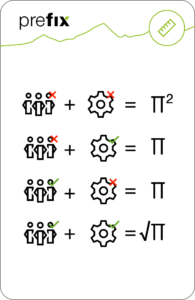How can you successfully estimate time and costs?

The challenge of each estimate is to identify the most realistic value possible, so that at the end of the project, the difference between the estimated value and the actual value is as small as possible.
To get as close as possible to this realistic value, I use the following approach:
- I start by noting the value that comes to me intuitively, whatever it may be.
- I use one or more of the following estimation methods:
- By breakdown. Breaking down the element to be estimated into sub-elements, up to a level at which it becomes possible to make an estimate.
- Expert judgement. Consultation with people experienced in the field related to the item being valued.
- Estimation by analogy. Reference to similar projects or project elements whose value is known through experimentation, while adapting this value to the new context.
- Parametric estimation. Estimate based on statistical data specific to the field of the element being estimated.
- Mean value. Calculation of an average value, based on the most optimistic value and the most pessimistic value.
- Poker planning. Collaborative and consensual estimation method, using a pack of cards bearing different values.
- I add to the value obtained a reserve linked to the level of uncertainty in the estimate. This reserve can range from 10% to cover a minor contingency to 300% for highly uncertain situations. For very specific projects, some people use the pi-figure method to define the reserve to be included in their estimates.
- I compare the intuitive value with the value established using one of the above methods. If they are consistent, I have sufficient confidence in the value established. If the values are inconsistent, I redo the intuitive estimate and use other methods.
The pi-figure method
The pi-figure method is entirely empirical and can be interpreted by the fact that a non-performing team spends 3x as much time carrying out the tasks it has estimated and that there is 3x as much work behind the unknown tasks.
The method therefore consists of combining these two factors to estimate the amount by which the value should be multiplied to include the reserve, according to the following rules:
- π^2 when the project team is not yet performing well and is doing something it does not know how to do,
- π when the project team is not yet performing well but is doing something it knows how to do,
- π when the project team is performing well but doing something they don’t know anything about,
- √π when the project team is performing well and doing something it knows how to do.

